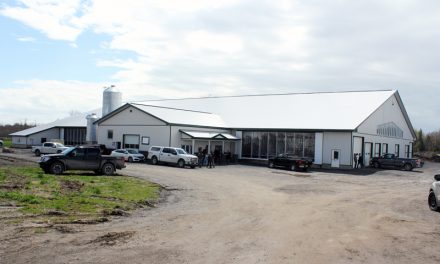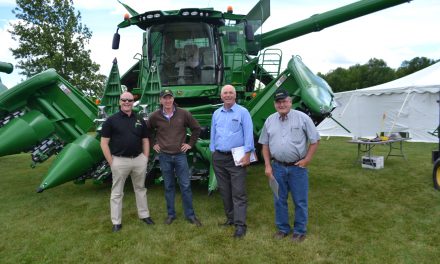Trusting your animal is key to enjoying you animal. Walker Photo
Get involved! Consider leasing a horse!
By Caylyn Walker
AgriNews Contributor
In part one of this series we discussed finding a local, reputable riding stable and enrolling in a lesson program. Once you have found a fabulous barn family and have learned basic riding and horsemanship skills, it is time to become further involved. If competing at horse shows is on your priority list, be sure to let your coach know so they can adequately prepare you for that avenue. Often, if you are planning to compete, you will need to be riding more frequently than the typical once per week riding lesson. Competing will necessitate not only the horse being in peak performance, but the rider as well must be fit. We will cover more in depth about horse showing in another article, but it is a topic to keep in mind as you think about your riding goals.
If competing is not a high priority for you, take a minute to think about what aspects of horse interaction you really enjoy. Do you like to ride for pleasure? Do you enjoy trail riding? Maybe you want to learn how to drive a horse or perhaps you are more fascinated with working on the ground with your horse. Owning and interacting with a horse does not necessarily mean you need to ride. There are plenty of other avenues you can explore that do not require being in the saddle. Liberty work (working with your horse with no equipment or tack) is becoming extremely popular in the industry, with a large following. Driving is also very diverse with vast subjects of interest within the discipline! Discovering what it is that really draws you to horses and what motivates you to work with them is a key step to understanding what type of horse you might look to buy in the future.
As you become more involved in the equine community, you may find local riding clubs in your area that provide unique opportunities and learning experiences. Pony Club and 4-H are two nationally available programs that are widely recognized. They offer a structured approach that includes organized events, games and horsemanship levels. 4-H is available to people 9-20 years old, but youth and adults are integral to the 4-H family. Despite common misconceptions, there is no maximum age for joining Pony Club. Pony Club youth are considered to be from ages 6-25 years old. Both clubs usually keep costs’ low so that they are accessible to all members. Other local clubs might also be available in your area. Trail riding clubs, endurance clubs, and even driving clubs are quite common in most areas. Several horse breeds also have province or region specific clubs as well that are well worth checking out! You may find, however, that in order to participate in some of these clubs you must own or lease a horse.
What is “Leasing a Horse”?
Once you have spent even a small amount of time at a barn , you will hear the term “lease” come up. Leasing a horse is essentially renting it, usually under specific terms. The terms in a lease agreement can vary quite a bit, but most commonly there are two types of lease: a paid lease and an unpaid or “free lease”. A free lease is not quite as free as it sounds. In a free lease, the lessee (the person leasing the horse from the owner) is usually required to cover the costs of boarding and feeding the horse. Other costs that usually need to be covered by the lessee are farrier, worming and vet fees. It is important that these details are clearly laid out in your lease agreement to avoid future problems or confusion. In a paid lease, you will be expected to cover the above-mentioned items, and will also be required to pay either a monthly or yearly “lease fee” for the use of the particular horse you are riding.
Leases can be full leases, half-leases or partial leases. With a full lease, the lessee will typically have exclusive access to ride and work with the horse they are leasing and will be required to cover the full cost of items pertaining to the horse. They may also be subject to a lease fee (in a paid lease) depending on the agreement. In a half or partial lease, time spent with the horse will be split with another person or people. A half-lease typically allows a lessee to ride or work with the horse three days per week and another rider would ride the other three days while allowing the horse one day off. In a partial lease the lessee usually gets one or two days to work with the horse. In a half lease or partial lease, lease fees may also be applied on top of each lessee’s portion of the general care costs of the horse.
Vet costs can add up quickly if a horse gets injured or sick. Often people will have insurance in place for their horse, and it is important to understand the policy terms. Sometimes the insurance will only cover the death of the horse, but it can also include major medical expenses. In the event something happens to a horse you are leasing it is critical to know these details as the insurance company must be advised within a specified timeframe in order for costs to be covered. When leasing a horse you must also consider the additional costs of your lessons, any memberships you will require and show fees (if you choose to show).
There is also insurance available for riders. One of the most popular types of insurance you will hear of is Ontario Equestrian Federation (OEF) Insurance, which is mandatory for riders to have in order to be able to participate in most equestrian events. This insurance protects you in the event your horse hurts another person or damages someone else’s property. There are additional insurance packages you may add on to the base insurance such as tack insurance, emergency life saving surgery, member named perils and more. It is prudent to investigate the different packages available and select one that best suits your needs. Insurance through OEF is valid for the full calendar year and is paid annually to renew.
Why Lease a Horse Instead of Buying a Horse?
If you are paying all of the costs that are typical of owning a horse it might seem silly to consider a lease when you could purchase your own horse, so why do people lease? Leasing is a fabulous way to ride a horse that you may not be able to afford otherwise. Highly trained horses can be quite an expensive investment and leasing allows more people to ride a high caliber horse without having to come up with the enormous up front expenditure to purchase. Secondly, while learning to ride you may find you outgrow horses quickly. What might have been your favourite school pony initially might be a pretty boring ride now or it might not be capable of performing at the level at which you may want to compete. Leases are generally fairly short-term commitments, unlike purchasing a horse that may live 30+ years. A lease can also be a valuable option for someone who is not able to commit to riding or working with his or her horse 4 or more times per week. Many horses require consistent work, which can be quite a commitment if you work or go to school full time. A lease helps split up the responsibility of horse care to allow more flexibility in scheduling. Another reason you may consider a lease is to have a competent second rider working your horse. Horses, over time, can develop habits with their riders. Some of these habits can be good and some of them less desirable. Having a second rider who may have a different skill set than you or stronger riding skills can be beneficial to your horse’s training. Cross training can also help keep your horse’s mind fresh and engaged in the work he or she is doing!
Join us next issue for Part 3 of this article!













